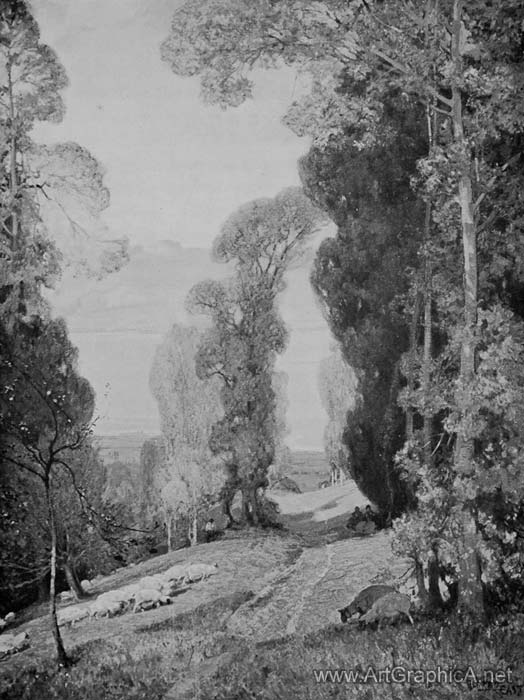Painting Materials |
||||||||||||||||||||||||||||||||||||||||||||||||||||||||
|
Page 03 / 14
EQUIPMENTCHAPTER IIIN the selection of your painting materials you must bear in mind that comfort and usefulness are of the greatest importance. The art is difficult enough without the additional drawbacks incurred by bad materials and inconvenient camp-stools and easels. A camp-stool that is uncomfortable, and that causes one to sit in a cramped position, or occasions a constant and distracting sense of its insecurity, is an unnecessary evil ; and one should also avoid an easel that requires a great deal of fixing, and arouses nervousness at every puff of wind. Nothing whatever in your apparatus should withdraw your mind from your work ; your whole attention is demanded in the production of a successful sketch. What can be more annoying, when one is striving to take full advantage of a passing effect, say of a distant rain cloud on a mountain side, if at the very moment a sudden squall overturns your easel, and you find your sketch face downwards on the ground; and this simply because you have an ill-constructed easel ? An easel for out-door sketching should combine the qualities of lightness and stability. If both cannot be secured, then by all means sacrifice the lightness, not the stability. For many years I have used a rack easel, revolving on a ball-and-socket joint, and stiffened at the desired angle by a thumbscrew. The legs are telescopic and can be shortened or lengthened to suit any irregularity of ground, and can be opened at so wide an angle as to render a sudden overturn by the breeze impossible. The rack can be so arranged that your picture can stand perfectly upright and firm--a very great advantage when painting in oil, as the reflection of the sky on the wet paint always creates a difficulty. As an easel for water-colour work it is admirable. A rack moving on a ball-and-socket joint can be pulled over into a horizontal position, which enables the colour to dry flat, and prevents it running down, as often happens when the ordinary upright position is maintained. The only fault possessed by this easel is that, in spite of its light weight, it is somewhat unportable. This, however, is only an objection when you are packing your things for a journey, and it can be overcome by taking the easel to pieces, and as the parts arc fastened by brass thumbscrews, the process need not be a labour. I have taken such an easel to many countries, and used it under all conditions, and found it excellent. Of course, it will not hold a larger canvas than the extent of the rack, unless you take the trouble to put two large screw-eyes into your canvas-strainer which will grip the rack behind.  Lake Bourget, From Mont Revard This device can be dispensed with if you are provided with a "Hook" easel, which, for large canvases cannot be excelled. This easel is so well known that it is scarcely worth while for me to describe it. As, however, this book may fall into the hands of someone who has not seen or used the apparatus, a few words of . explanation will not be out of place. Briefly described, it consists of three poles of seven feet long and about 1.5 inches in diameter, and five screw-eyes large enough to admit the poles. These screw-eyes are screwed into the back of the canvas-stretcher, and so form of themselves an easel. A small thumb-screw fixes the screw-eye on the poles at the elevation required. One screw-eye is hinged for the back pole. The advantage of this easel is, that it will firmly support any sized canvas up to six feet or more, and, by the addition of another ring and pole, it may be made to resist half a gale of wind, while a guy rope from the back pole screwed into the earth prevents it being blown over from behind. You can raise or lower the picture at will, and it can be placed at any angle on irregular ground. I have spoken of the necessity of comfort in painting, and you may be assured that an easy seat is of the highest importance for both health and work. How many students complain of indigestion, caused by the cramping of the stomach resulting from the use of a low stool I It should be as high as an ordinary chair, or at least as high as any seat you usually feel at ease in. To my mind, nothing is better than the tripod with a strong ox-hide top, which, while you are out in the country, can be temporarily fixed by a tack to the stool underneath. This plan prevents loss of time and trouble in adjusting the seat every time it is used. First you strain the best linen sail-cloth of moderately fine The medium and turpentine should be in square tin bottles with screw tops, and should fit snugly in their allotted places. The box should contain colour tubes in proportion to your needs. For instance, the largest will he white and the rest will vary according to the demands likely to be made upon them. I mention this, because weight is a consideration when one has to carry one's own painting materials, and it often happens that your subjects arc a considerable distance from your headquarters, so that you should take only the minimum weight. The colours constituting my palette, together with the sizes of the tubes usually taken in the box, are as follows :-
Vermilion can replace rose madder if desired. These should go into your box comfortably. The palette fits over them, and there is space for the dipper, which should be large enough to receive your largest brushes. The box is generally made to hold several wood panels, which slip into the groove in the lid. These are useful either for a study of the picture you are painting, or, if the effect you desire is not visible at the time, you can do a sketch while you are waiting till it comes on. I have found these wood panels the greatest solace. When you start out in the morning to a subject which may be miles away from headquarters, the day may promise the sunny effect you desire ; but just after you have arrived, fixed the easel, made sure of its stability, and added the security of the guy rope, the sun may abruptly conceal itself behind a block of clouds which seems to extend as far back as the eye can reach, and all your preparations appear to be wasted. One experienced in such matters knows how annoying this is. Unfortunately it is far too common an experience in our uncertain climate, and it is the more vexatious if you have walked some distance to paint a particular shadow across a road, or to correct your colour values by reference to the original conditions under which you started your landscape. This is a crisis where the pencils and panels come in so happily. Instead of tramping back in an evil temper, you can spend the morning in making a study, or doing a sketch under the grey sky which has postponed your larger enterprise. * If it is found that the lead fumes arising from the flake white are disagreeable and injurious. the new flake white prepared by Messrs. Madderston Co., which is harmless, might be used. [T] The small tubes arc suggested to save weight ; for studio work the Larger sizes arc better. The morning, after all, has not been thrown away. The panel is slipped into the groove of the lid of the box, and one has the satisfaction of feeling nothing has been lost by the change of weather, which at first looked like a disaster. It is difficult to give advice in the matter of brushes. Every artist has his own peculiar idea as to their make and shape. Some prefer a round full brush, others a thin flat one ; some again like round thin ones, and others just the opposite. No doubt the pattern of brush must depend mainly upon the nature and method of the work. In the case of those who paint from a. generous palette, it is necessary to select brushes that will hold a larger quantity of colour. One's choice must also depend upon whether one uses the colour direct from the tubes without dilution, or whether a greater quantity of oil or other fluid medium is employed. I remember this problem weighing upon the mind of a distinguished lady, who was buying her colours with all the difficulties of tree painting confronting her. She inquired if the shopkeeper had any " tree brushes ": The man was equal to the occasion, for, bringing round some brushes, he assured her they were exactly the same as "So-and-so" (mentioning an eminent painter) used in painting landscapes. I beg of you not to get any fads into your head as to any easy or special method of arriving at certain results. There is but one method. It is the familiar and only effective one, namely, that of study and hard work. The achievement is not reached by the style of the brush, but through the training of hand, eye and brain. But though you may not ask for " tree brushes," yet you would naturally like to know how trees are painted. " They are such tiresome and difficult things to paint," I can fancy you saying. Well, they are. But later I will give you a few hints which may help you. Meanwhile we must have all our painting materials in order before setting out to work, and not the least important items are the quality and size of your brushes. Let them be of the best, for these are the cheapest in the end. I use a full hog hair brush, of a size from i to 8, and one or two small sables, sizes 0 to 2. A few longhaired sables may be convenient for drawing the branches of trees. Two each of these sables, and three or four each of the medium-sized long hair, and one or two larger ones, will be sufficient. At the end of the day's work always wash your brushes, either in turpentine or with soap and warm water, or put them in a vessel containing paraffin oil. Now I have provided you with camp-stool, easel, a box containing colours, medium, spirits of turpentine and brushes. By the way, I should advise you to use oil copal medium. It is safe and dries well.' Do not forget to take a piece of painting rag ; you will find butter muslin, costing about 3d. per yard, excellent for both water colours and oils, and it is effective for wiping off colour, if necessary. To sum up with a few practical hints : * Quick drying poppy all Is excellent, or a medium made of equal parts of spirits of turpentine, linseed oil, and amber or copal varnish is good. Don't be in a hurry lest you forget something that is necessary. Be provided for an emergency, such as a change of effect. Don't be too respectful to Nature at the beginning, but very much so when finishing. Open your heart and eyes widely. Don't be perverse. Approach Nature with the heart of a child. Don't try to be sincere, but be so, and be strong.
Next Page
Prev PageSketching from Nature Painting Nature
|
||||||||||||||||||||||||||||||||||||||||||||||||||||||||








